Log Cabin Cost
Last updated 24th July, 2024
Are you thinking about building a log cabin?
Look no further, because this article has all you need to know about the cost of building a log cabin. We look into log cabin kits, the pros and cons of building a wooden cabin yourself, plus the supply costs and labour fees if you were to pay a tradesman to complete the work.
Average prices range from around £5,000 for a mobile, small log cabin, up to £120,000 for a larger scale project.
Continue reading for more information!
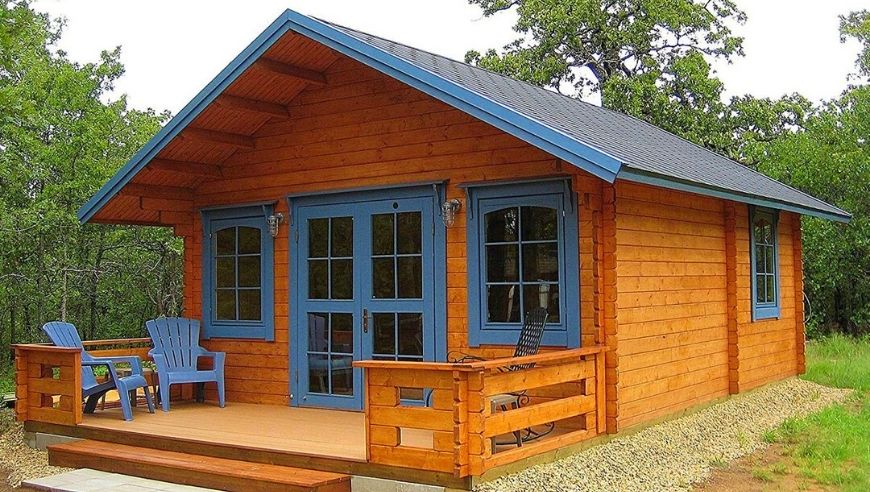
How Much is a Log Cabin?
There are many variations of log cabin on the market and just as many sizes due to the increased popularity in recent times. From garden rooms or camping pods to full residential log homes, the intended usage will determine the price of your log cabin.
Mobile Log Cabins
Mobile log cabins are popular alternatives to traditional caravans with better insulation and more visual appeal, especially in countryside locations. Camping has had an upgrade in the last fifteen years or so with the idea of ‘glamping’ in a specially designed wooden cabin.
No more shivering in flimsy canvas tents or thin-walled caravans, the new camper wants solid walls and comfort, and so camping pods were born. Mobile log cabin camping pods can range in price from between £2,000-£30,000 according to size, style, and finish.
Summer Houses and Garden Rooms
The more traditional log cabin UK style is a summer house or garden room. Again, size and style will determine the price, but the average cost will be around £2,000-£7,500. Some of these will be insulated for year-round comfort, although this will depend on how utilised the building will be.
Summer houses will typically only be used in the warm weather, but a well-insulated garden room can serve many functions and be comfortable all year round.
Residential Log Cabins
Full residential log cabins are an alternative to conventionally structured masonry homes and are seen as more environmentally sound and economical. Timber is an excellent insulator, and so the benefits of a full timber-built wood cabin house are appealing to many.
The size of the building, number of bedrooms and the final finish will dictate the price, but the average price range is between £50,000-£120,000 for a residential wood cabin.
Apart from the size and design, the type of timber that the log cabin is manufactured from, and the way that it is put together will have an impact on the cost. Imported or UK grown Western Red Cedar, or Douglas Fir are popular choices for constructing log cabins, but the price will vary. Whether the build is hand scribed or machine jointed will also have an effect on the cost.
Typically hand scribed log cabins are 30%-40% more expensive due to the increased labour and timeframes involved.
The ease with which the site for your log cabin can be reached will also have an impact on the overall cost. If you have a site in the middle of woodland perhaps accessed by a forest track then this may be logistically more difficult and therefore more expensive than an average building site. Sites in hilly or mountainous regions may also be challenging for access particularly in bad weather.
Some log cabins can be supplied as just the framework of logs with the sealing and weatherproofing left to the client. This can mean a wide variety of finishes and a range of quality in terms of materials used to roof, insulate, and glaze the completed property. These choices will affect the price of the log cabin.
The cost of building a log cabin as a permanent residence will need to include the price of the groundworks. The extent and type of foundations will depend on the size and style of the log cabin as well as the type of soil on the site.
However, some log cabins are classed as mobile in that they are not built on foundations but rest on supports instead so groundworks for these log cabins will be minimal. In general, 10%-20% of the cost of building a log cabin will be for the foundations and groundworks.
Other Considerations
Decorating and finishing will add to the price of your log cabin and this will depend on your budget and personal preference. Many styles of log cabin leave the timbers visible internally and some are covered so this will affect how the final decoration of the property is done. The finished look can range from rustic, to homely or modern depending on your taste.
Ultimately the cost of your log cabin will be contingent on its size, design, construction method and choice of finish. You can choose to have the basic log framework, sealed shell or turn key options for most log cabins and there are many bespoke options available too.
It will also depend on the use to which the log cabin is being put whether it is residential, a holiday chalet, garden room or summer house.
Table of Contents
- How Much Does it cost to build a log cabin cost?
- Labour costs and time frames
- Cost affecting factors of building a log cabin
- What does building a log cabin entail?
- DIY log cabin build
- Choosing a log cabin
- Choosing log cabin timber
- Choosing a log cabin roof
- Building regulations for building a log cabin
- Planning permission for building a log cabin
- Demolishing a log cabin cost
- FAQs
- How to find & hire a log cabin builder
- Sources
Log Cabin Prices
Some large residential log cabins can be bought in order to self-build or hire your own trades for construction and fit out. Most however come as a design and build service with the cost of the construction included in the price.
Average cost of residential log cabins based on square meterage.
| Residential | 50m2 | 85m2 | 95m2 | 110m2 |
|---|---|---|---|---|
| Price range | £50,000-£90,000 | £65,000-£100,000 | £75,000-£110,000 | £85,000-£120,000 |
| Average cost | £65,000 | £85,000 | £95,000 | £105,000 |
Average cost of residential log cabins based on size of log from 75mm to 150mm. BS3632 is based on a 75mm solid log with internal insulated lining and a log face finish. This complies with the standard to which mobile and residential park homes are built.
| Residential | 9mx6m | 10mx4m | 10mx6m | 12mx6m | 14mx6m | 15mx6m | 16mx6m |
|---|---|---|---|---|---|---|---|
| 75mm | £65,000 | £50,000 | £64,500 | £70,000 | £75,500 | £92,000 | £92,000 |
| 150mm | £75,000 | £61,000 | £78,500 | £85,000 | £93,000 | £112,000 | £114,000 |
| BS3632 | £72,000 | £57,500 | £72,500 | £78,000 | £85,000 | £100,000 | £102,000 |
Supply Costs
If you know how to build a log cabin UK companies can provide the complete kits on a supply only basis. Below are some average supply costs for different types of log cabin such as garden cabins, summer houses, garages as well as mobile homes and camping pods.
| Garden cabin | 4m x 3m | 4m x 4m | 4m x 5m |
|---|---|---|---|
| Price range | £2,000-£6,500 | £2,500-£7,500 | £3,000-£7,500 |
| Average cost | £3,500 | £5,000 | £4,500 |
| Summer House | 4m x 4m | 5m x 4m | 5m x 5m |
|---|---|---|---|
| 40mm | £3,500-£4,000 | £3,600-£4,500 | £4,200-£5,200 |
| 75mm | £6,000-£7,500 | £6,000-£8,500 | £10,000-£12,000 |
| Type | Average Cost |
|---|---|
| Mobile | £20k-£30k |
| Home Office (insulated) | £6k-£10k |
| Camping Pods | £2k-£10k |
Additional Costs
The cost to install lighting in the log cabin will depend on the type and number of lights that you choose. There is a vast array of lights available from pendants to floor lamps in a range of prices. Be aware that you must use a qualified electrician to carry out any electrical installation in your log cabin.
The cost of an electrician in London is approximately £40-£60 per hour while in the rest of the UK this is around £30-£40 per hour.
If you install a log cabin in your garden and want to use it year round you will need to make sure that it has sufficient heating. By choosing to install a wood burner you are creating a cosy and inviting space that you will want to spend time in.
To fit a wood burner would cost you between £1,500-£2,500 including a metal flue and a suitable hearth. If you intend to use the log cabin as a home office you may want to install a toilet or even a full bathroom if space allows. The cost to fit a toilet and wash hand basin in a log cabin will be around £1,000-£1,500.
If you choose laminate flooring for your log cabin it will cost £500-£900 for around 25 square metres depending on the quality. Solid wood flooring will cost significantly more at between £1,200-£1,500 for 25 square metres.
Decorating the internal walls of your log cabin will cost around £200-£250 if you intend to hire someone to paint them for you. To do this as a DIY job the cost will be around £5-£10 per litre for good quality paint. Painting equipment will cost around £10-£15 for a roller and tray and some masking tape. You may wish to wallpaper one wall as a feature and a mid-quality wallpaper will cost between £10-£25 per roll.
To increase the overall floor space of the log cabin many people choose to install decking to the front or side of the building. The cost to install timber decking will be between £15-£90 per square metre depending on the type and quality of the wood.
Cost Breakdown Calculator
Individual costs to build a residential log cabin of 50 square metres - Total Cost: £65,000.
Materials
£32,500
Tradesmen
£26,000
Waste Removal
£6,500
Labour Costs and Time Frames
The labour costs for a design and build residential log cabin will be included in the overall price that you pay. However, it is possible to purchase the framework and employ your own tradesmen or if you are experienced enough to construct a DIY log cabin.
The intermediate option is to have the log cabin constructed to a ‘sealed shell’ stage where it has been weatherproofed and finish the fit out yourself. This means that the roof, windows, and doors are fitted but the internal electrics and plumbing, flooring, and decorating will be down to you.
The cost of building a log cabin does not normally include footings or getting services such as electricity, water, and drainage on site and these incur a separate cost.
Other Costs
As well as the cost to build a log cabin there are other labour costs involved in a design and build project. The design, specification and structural calculations for a residential log cabin will need to be carried out prior to manufacture and assembly. The cost for this will be around £850-£1,000.
Some log cabin suppliers have their own factories and source their timber from places such as Finland and Russia so the logistics of getting from design to construction involve many different costs.
Hand scribed logs will take longer and cost more than machine profile timbers. The skill and times that this process takes means that hand scribed log cabins will be up to 40% more expensive than machined milled. However, the benefit is a more bespoke finish as well as the precise fitting of logs which means a better insulated house.
Most smaller log cabins such as summer houses and garden rooms are sold as a kit that you put together yourself or you can hire someone to construct for you. The cost for this would be around £150-£250 per day, usually for a team of two.
Log cabin holiday chalets and mobile homes are normally delivered to site in sections and are erected on site.
Timeframes
The process of buying a residential log cabin will be longer, more expensive and take longer than most other types of log cabin. This is because most will need to be designed, manufactured, and built to specific building regulations and structural calculations unlike smaller log cabins.
A small log cabin of around 3m x 3m will take a day to build. Slightly larger garden rooms or summer house log cabins may take two to three days to construct. A log cabin of 30 square metres or more will likely take four or five days to construct fully.
For fully residential log cabins that have to conform to building regulations the construction time will be approximately 8-12 weeks. Some manufacturers will take several weeks to source the timber for a log cabin while others will first assemble the log cabin at their own premises, number the parts and then re-assemble the pieces at the client’s own site.
This is to ensure that all the logs are properly and precisely fitted prior to arrival at the customer’s location. This can add to the overall timeframe but is deemed necessary to provide a solid construction.
The foundation for a residential log home will need to be full footings and a solid concrete base and these may take up to four to five days to complete. The construction of a log cabin roof may take three to four weeks to complete.
Doors and windows can take another two weeks and the internal fit out will take another four to six weeks depending on the finish.
Cost Affecting Factors of Building a Log Cabin
Many things will affect the cost of your log cabin including the type that you choose, the timber it is made from, the size of the cabin and the quality of the finish.
Type of Cabin
The type of log cabin that you choose will depend on the use that you wish to put it to. Perhaps it will be a summer house or home office within your garden or a mobile home for relaxing breaks or to rent out as a source of income. Or you may want to build a full residential log cabin as your main home.
Size of Cabin
Garden rooms or summer houses come in lots of different sizes from 3.5m x 3.5m up to approximately 9m x 6m and above. They are typically constructed from 28mm, 40mm or 45mm logs and are not normally insulated. Prices range from £2,000-£7,500 depending on size, style, and finish.
Mobile homes are considered to be those that can be disassembled into sections and move from one site to another. They are usually installed without being set into foundations although they do require a firm and level base.
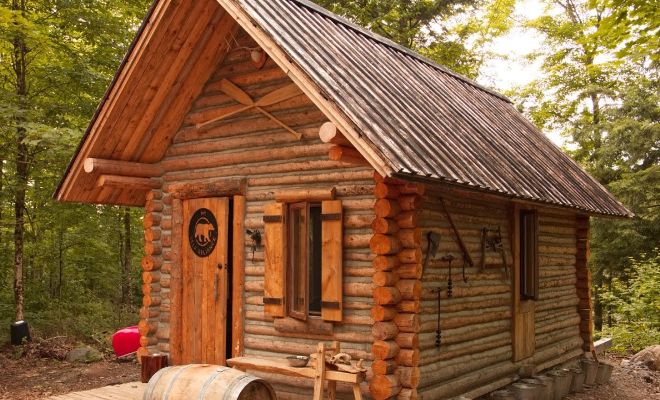
Mobile log cabins come in lots of different styles such as a classic chalet style, a shepherd’s hut, or an ultra-modern camping pod. They range in price from £2,000 to 30,000 or more depending on specification.
Full log homes that are designed and built for permanent dwelling are unsurprisingly the most expensive log cabins to build. The size, design, amount of materials and finish that is required in a residential log cabin mean that they can cost from £50,000-£130,000 to construct.
The cost for residential log cabins also has to include planning and design, structural calculations, and groundworks, all of which are not applicable to other types of log cabins.
Type of Timber
The type of wood that your log cabin is made from may affect the cost. The most popular types for the construction of log cabins are Western Red Cedar, Douglas Fir and Spruce.
The cost is further differentiated between timber that is grown in the UK and imported timber. Some log cabin manufacturers prefer timber from cold parts of the world such as Finland, Russia, and Canada. These produce much denser timber due to the slow growth in such climates.
Trees in the temperate climate of the UK grow more quickly and the timber is therefore not as dense meaning it is prone to absorbing more water. Western Red Cedar is more expensive than Douglas Fir and imported timber will be more expensive than home grown.
Access
Location of the site for your log cabin can have an impact on the costs. If the site is remote then you may incur extra charges for delivery not just of the log cabin itself but also things like scaffolding and skips.
A sloping site will either require extra excavation or specialised foundations and this may have a cost implication. Narrow roads or twisting mountainous roads may make deliveries difficult and increase their cost. There is also the need for workers and equipment to get to site and be safe to use once there.
Quality
The quality of materials will also have implications for the cost of building a log cabin. Not only the timber that the logs are cut from but also the roofing materials, insulation, and internal fitout. The difference in the diameter of the logs will have a significant impact on the overall cost with a 20% increase between 75mm and 150mm logs.
For example, a 15m x 6m cabin in 75mm logs will cost on average £90,000 while one constructed from 150mm logs will cost approximately £110,000.
Imported timber will also be more expensive than home grown although it may have better durability if grown in cold environments.
The quality of the logs for a summer house or garden room will not be the same as those for a full residential log home which will have to meet Building Regulations. Finally, the quality of the internal fitting will have implications for the cost to build a log cabin.
Groundworks
The cost of groundworks will vary from site to site and on the different types of soil on the site of the log cabin.
Sandy or chalky soil mean that foundations may need to be dug deeper and this may have cost implications both in terms of labour and equipment hire. Rocky ground may take longer to excavate and be similarly expensive.
There are many different types of foundations and the kind of log cabin being constructed will also determine which are most appropriate or suitable. For small garden rooms, home offices or summer-house type log cabins a concrete base is normally sufficient.
Pillar foundations are single points of load and are placed at each corner of the log cabin while strip foundations are shallow trenches of concrete on which the structure is built. Strip foundations will cost around £100-£120 per square metre.
The type of foundation will also be determined by the terrain of the site and this aspect of the build can also have cost affecting factors.
A sloping site can present problems which can be expensive. If the sloping site is levelled this will involve a lot of landscaping which will be costly in terms of labour, equipment, and time.
The alternative is to have pier foundations which will negate or at least diminish the need for large scale excavation and landscaping thereby saving time and money.
Services
The price of providing utilities such as electricity, water, and drainage will need to be considered and these costs will depend on accessibility to existing utilities and the area that you live in.
For a residential log cabin, you may need to factor in the price of gas or oil fired central heating, solar panels, or other eco-friendly heating such as ground or air source heating.
Location
If your site is in a remote area you may need to provide crew accommodation and welfare facilities for the contractors building your log cabin. The cost will obviously depend on the number of people working on site, how long they will be there and the area that you are in.
Decorating
Once your log cabin is built you will need to consider the cost of decorating. You can either do this yourself or hire a professional decorator. The latter will cost you around £120-£160 per day. This will depend of course on the size of the property and type of decorating they are doing e.g. painting, wallpapering etc.
What Does Building a Log Cabin Entail?
How to build a log cabin will depend on the size, type and intended use of the structure once it is complete. There are lots of varieties, shapes, sizes, and functions but all need to pass through certain stages before they fulfil their purpose.
Groundworks
The first step in building a log cabin is to ensure that the foundations are correct and appropriate for the type of structure they will be supporting. Foundations are essentially the core of the building and so need to be capable of taking the structural load.
There are several different types of foundations and the size and type of log cabin you are building along with the condition and soil type of your site will determine which foundations you should by used. This is probably the most crucial stages of the build and if it is not done correctly will be very difficult to fix and could compromise the integrity of the log cabin.
Construction
Before beginning to construct the log cabin the base should be checked to ensure it is level and solid. The components of the log cabin will most likely have come in one or two packs. They should not be unpacked until the day of installation to protect them from the elements.
The foundation beams are installed first, these sit between the base and the first log to ensure that the cabin is not in direct contact with the ground and provide the opportunity for air flow and ventilation beneath the cabin. They may be tanalised or profiled to aid water run-off.
The foundation frame then can begin to be assembled and screwed together. This should be checked at intervals to ensure that it is square and level. The walls can now be built. The first row are fixed to the foundation frame and the diagonals checked before proceeding.
The joints between the wall planks will normally be tongue and groove and these are fitted together by tapping with a rubber mallet or similar. The foundation frame and first row of wall planks are fundamentally important to get right as this will provide the basis for the rest of the build.
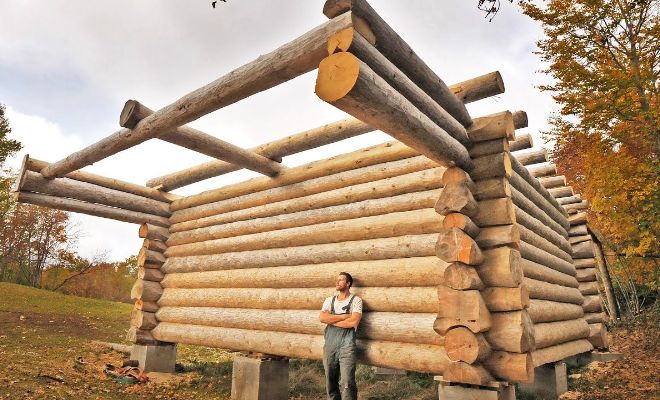
Subsequent rows of wall planks are installed without the need for screws. Some wall parts such as around windows or doors may be supported with metal rods which are inserted through pre-drilled holes in the wall planks.
Some cabins will have windows and door frames that slot into the walls and some will have surface mounted window and door frames where the apertures are incorporated into the wall plan.The top row of wall planks may have pre-cut holes to accept the roof joists.
Storm braces may be supplied with the cabin and these are inserted into pre-drilled holes at points throughout the structure and serve to strengthen it. Roof joists are now installed and once in place the roofing planks are fitted. The roof is then covered in felt, tiles or other roofing choices. External doors can then be hung on the door frames.
Internal
The flooring can be installed and is fixed the foundation frame with nails or screws. Some may have to be trimmed or adjusted to fit around door frames.
Skirting can be fitted around the perimeter of the cabin to give a neat finish and hide any uneven edges of the flooring. Window and door furniture such as handles and locks can be fitted.
Treatment
Different methods will be used for different types of log cabin. Mobile homes and camping pods will be slightly different from summer houses or garden rooms as they often come already assembled or in two or three parts.
Constructing a full residential log home will obviously be a lot more involved, take longer and need to comply to Building Regulations.
DIY Log Cabin Build
A garden log cabin is an ideal DIY project and well within the ability of most DIY enthusiasts. However, if you intend to build a full log home to live in permanently then it would be best to approach this as you would a traditional masonry house.
Would you feel confident about building a masonry home yourself? If the answer is yes and you have the capability then there is no reason why you shouldn’t build a log cabin home yourself as long as you adhere to all planning and Building Regulations.
Dangers of DIY
There are many inherent dangers in DIY and particularly in large projects such as building a log cabin. You will most certainly need help for a portion of the build and lone working is risky in the event that you are injured.
Working with timber invariably means the use of power tools such as skill saws which can be extremely dangerous if not correctly used or operated while tired or distracted. Other power tools such as nail guns or drills are equally hazardous if not used with care and in the correct way.
Crush injuries are a real danger and especially if the log cabin you are building is being constructed with large logs.
Avoid lone working and ensure that you are always wearing the appropriate safety clothing for the task that you are carrying out.
DIY or Professional Contractor?
Unless you know how to build a log cabin from scratch it is more prudent to involve professional log cabin builders. They will have experience and the right equipment for doing the job properly and to a good standard.
Of course, there are some parts that you could do DIY such as the clearing of the site to reduce the time and expense of having the contractor do it. If you are an experienced DIYer then you could do some of the internal fitout or do the decorating yourself.
How Much Would DIY Save?
The amount that you would save by doing the entire build yourself will depend on the size and type of log cabin. For a full residential log cabin, the cost of labour is often equal to the price of the material. So, if you buy the components for your cabin at a price of £65,000 then you may save the same amount in labour if you choose to do it yourself.
However, bear in mind that you will not be able to carry out the full project yourself without help. This is particularly the case for services such as electrics, plumbing and drainage for which you may still have to pay. You will also have the expense of groundworks, waste disposal, scaffolding, and site equipment to deal with.
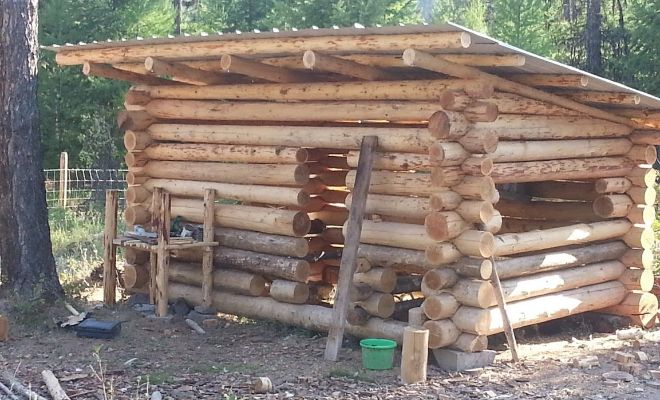
It is often overestimated how much can be saved by doing a large project yourself as the timescale will invariably be longer without professional trades on site working simultaneously. People also underestimate the value of their own time which will be spent on such a large project or are unrealistic about how much of the build they can do themselves.
While they may feel they are saving the cost of labour in actuality it may be more economically viable to pay experienced installers to do the work in less time.
Tools Required
The tools and equipment that you would need to build a log cabin in your garden are as follows:
- Spirit Level
- Screwdriver
- Measuring tape
- Hammer/rubber mallet
- Hand & circular saw
- Pliers
- Electric drill
- Craft knife
- Ladder/working platform
- Silicone
- Assembly drawings
Safety Equipment Required
The following safety clothes/equipment should be used when you are building a log cabin in your garden:
- Protective gloves
- Safety goggles
- Steel toe capped boots
- Dust mask
Small garden log cabins do not need to adhere to any Building Regulations if they are less than 30 square metres, have no sleeping accommodation and are more than a metre away from the boundary and constructed substantially of non-combustible material. Full details can be found on the government website which deals with Building Regulations.
Obviously, a larger cabin which has sleeping accommodation will be subject to Building Regulations and full residential log homes must meet full Building Regulations and be signed off as having complied with them.
Choosing a Log Cabin
Garden Rooms Cost
There are many types of log cabin that you can put in your garden such as summer houses, home offices, or a play house for your children.
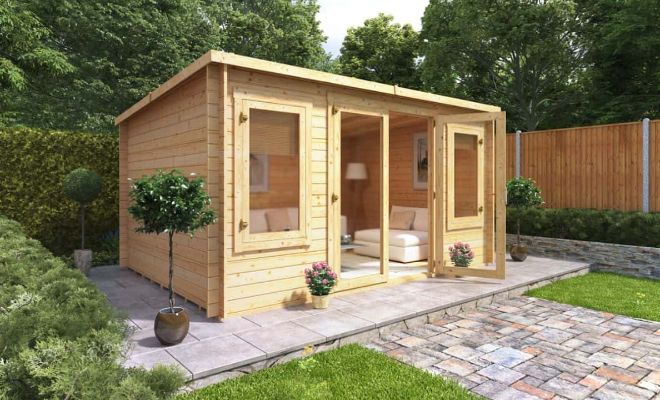
The average cost of a 4m x 4m log cabin garden room is £5,000.
Pros of a log cabin garden room:
- ✔ Can be built under permitted development providing the conditions are met.
- ✔ A relatively easy DIY project.
- ✔ There are no Building Regulations to be adhered to.
Cons of a log cabin garden room:
- ✖ They may only be used for part of the year when the weather allows.
- ✖ Valuable garden space can be taken up.
- ✖ Will need regular treatment with a wood preservative to maintain.
Mobile Home Cost
A mobile home is a structure designed for human habitation that can be moved from one location to another in one or two sections.
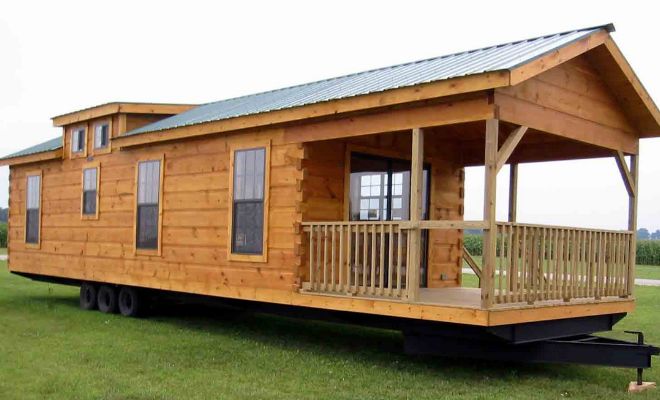
The average cost of a mobile home log cabin is £25,000.
Pros of a mobile home log cabin:
- ✔ Many different designs, styles, and sizes to choose from.
- ✔ Can be moved to a site in one or two pieces.
- ✔ Ready to be connected to water and waste services on site.
Cons of a mobile home log cabin:
- ✖ Must comply with BS3632:2015.
- ✖ A suitable site with planning permission will usually be needed.
- ✖ Cannot exceed 20m x 6.8m to be classed as a mobile home.
Full Residential Log Cabin Cost
A full residential log cabin is one which you intend to be a permanent home and which will need to comply with Building Regulations.
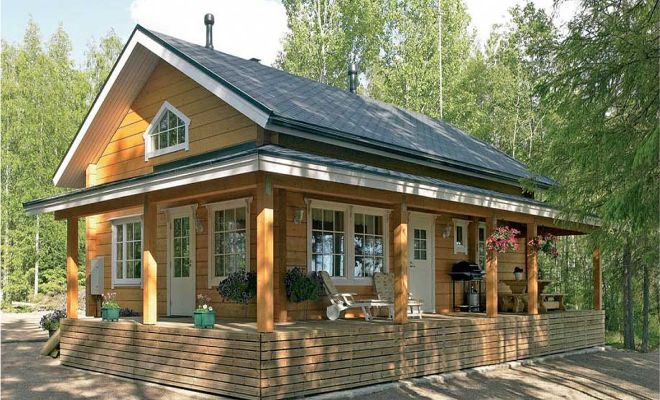
The average cost of a 100 square metre full residential log cabin is £105,000.
Pros of a full residential log cabin:
- ✔ Available as log only framework, sealed shell of turn key finishes.
- ✔ Many different designs, styles and sizes to choose from.
- ✔ Aesthetically pleasing, well insulated and environmentally friendly.
Cons of a full residential log cabin:
- ✖ It must meet the necessary Building Regulations.
- ✖ Price is just for the cabin; you still need to pay for the site and services.
- ✖ Finding the right site may be difficult.
Choosing Log Cabin Timber
There are three main species of timber that are used to build log cabins in the UK, Western Red Cedar, Douglas Fir and Spruce.
Western Red Cedar
This is an evergreen tree that can grow up to 65 metres and is grown in the UK for timber and hedging. The timber is one of the most durable in the world and contains a natural preservative which is resistant to fungal attack. Imported Western Red Cedar usually comes from Canada or Alaska where it grows more slowly due to the colder climate and produces a beautiful grain as a result.
The colouring between UK grown and imported Western Red Cedar is different. Imported varieties are a deep red/brown colour while home grown is a paler shade of red. UK grown varieties are also more knotty due to the faster growth in a more temperate climate. Western Red Cedar is the most expensive of the timbers most commonly used in the construction of log cabins.
Douglas Fir
Douglas Fir trees are coniferous tree that can live for up to 1,000 years. It is a tall and straight growing tree and can reach heights of 60 metres. A strong tree, the UK grown varieties are described as slightly durable while imported varieties are moderately durable. The colouring is a reddish-brown colour although when freshly cut it is pinker.
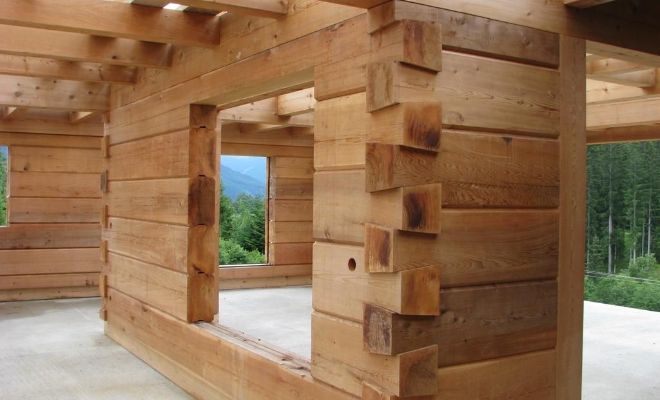
They are a good choice for log cabins as they maintain the width of their trunks throughout their height and are less likely to taper at the top of the tree. The cost of imported Douglas Fir will be higher than home grown varieties. Douglas Fir is not as costly as Western Red Cedar but just as widely used in the building of log cabins.
Spruce
This conifer grows all over Northern Europe and is used in construction for flooring, roofing, and furniture. The colour can range from creamy white to a red brown and trees can grow up to 30 metres. It is a straight grain timber with a medium density with a good weight to strength ratio.
Spruce also does not discolour as easily as pine and so is nicer to have exposed on the interior of log cabin. It does tend to be a bit knottier than pine although some people like that look. Spruce is used in smaller log cabins such as summer houses and garden rooms rather than in the larger residential log cabins.
Choosing a Log Cabin Roof
Different log cabins will have different types of roofs such as pitched or flat roofs depending on the size and use of the building.
Flat Roof
Many small garden log cabins or home offices will be made with flat roofs although they are never completely flat and will have a fall to allow rain water run-off. These roofs were usually covered with felt years ago and some still are.
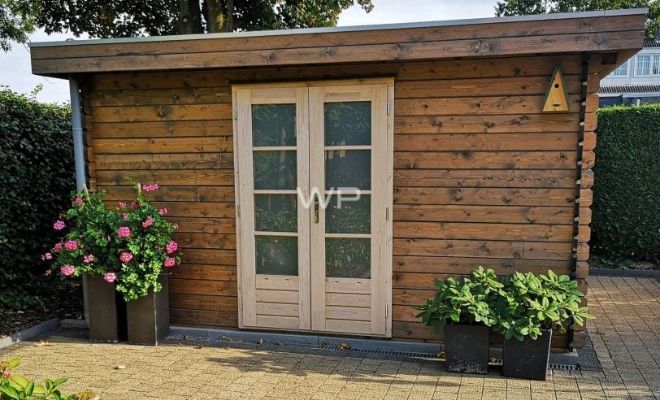
However, felt has several issues which make alternatives more appealing. The first is that felt will need regular maintenance, repair, and possible replacement. It has a tendency to rip and only has a life expectancy of 10 or so years.
EPDM Rubber Roof
For the last couple of decades EPDM rubber has started to replace felt as the flat roof covering of choice. It is relatively easy to install, is low maintenance and will last up to fifty years. It does have a couple of negative points, however. It is not suitable for foot traffic and can puncture under heavy impact.
However, it can be used in conjunction with a green roof system. The cost to install an EPDM rubber log cabin roof will be between £40-£50 per square metre.
GRP Roofing
Glass reinforced plastic is a strong and durable roofing material and can be used on a log cabin roof. It will take foot traffic and is resistant to impact. It also has a contemporary and seamless look although it can however be a little tricky to install as a DIY task.
Finally, due to its rigid nature it may be prone to cracking. The average cost of GRP roofing is between £70-£100 per square metre.
Sedum Roof
Flat log cabin roofs are also suitable for a sedum system roof. This is also called a green roof as it is essentially a living ecosystem. Sedum is a succulent which is very hardy, is acclimatised to the British weather and requires little or no maintenance.
A waterproof membrane is placed on the roof and mats which are embedded with sedum are rolled onto the roof. This type of roofing is environmentally friendly, a good insulator of heat and sound and looks beautiful. The cost to install a sedum roof will be on average £50-£80 per square metre.
Zinc Roof
Zinc is a very contemporary looking roofing material and it does suit flat and very low pitched roofs however it may not suit some log cabin styles. It is also a very specialised job and can be an expensive option. The cost of zinc roofing is between £100-£130 per square metre.
Cedar Shingles
Cedar shingles are a renewable and sustainable roofing material which look good and provide good insulation. They are light but durable making them a good choice for a log cabin roof. The average cost of cedar shingles is £25-£30 per square metre depending on size and quality.
Pitched Roof
Many people prefer the look of a pitched roof whether that is on a small garden room or a full residential log cabin.
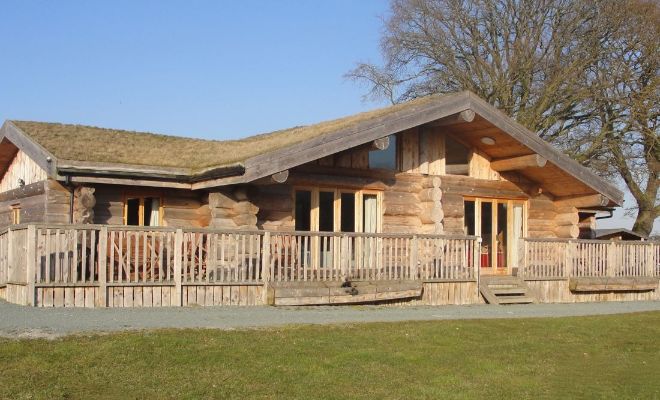
Of course, for weather proofing a pitched roof is much easier to maintain as gravity and the design of the roof take care of most of the water run-off. The degree of the pitch will preclude the use of some roofing materials.
Slate Roof
Slate as a roof covering is a beautiful material for a pitched roof and would look good on a residential log cabin. Natural slate will be more expensive than its man-made counterpart although it is difficult to tell them apart once they are fitted. Fitting slates is a labour intensive job but the finished look will be worth the expense.
It is a highly durable material with extreme longevity and can be put on almost any kind of pitched roof. The cost of slate will depend where it has been sourced from. Spanish slate is cheaper than British slate at on average £25-£30 per square metre. Welsh or Cornish slate will be more expensive at between £40-£60 per square metre.
Clay Tiles
Clay tiles are another natural roofing material with intrinsic beauty and aesthetic appeal to suit a log cabin. There are numerous shades and they retain their colour with only weathering affecting the look slowly over time.
Machine made clay tiles are more durable and resistant to the effects of climate and the environment. Variations in the natural shading of clay tiles enhance their appearance. The cost of clay tiles can range between £60-£100 per square metre depending on whether they are plain or interlocking tiles.
Concrete Tiles
Concrete tiles are less expensive than clay tiles but will not always retain their colour in the same way as a clay tile. The colouring of some concrete tiles is surface treated which means over time this will fade and be washed out.
Some however, can be coloured throughout the body of the tile and sealed with an acrylic protective coat. This can also protect the tiles against extraneous dirt, moss, and lichen growth.
However, they may not be as complimentary to the look of a log cabin as some other roofing options. The average cost of concrete tiles is £35-£50 per square metre.
Thatched Roof
Thatch as a roofing material is beautiful to look at and would suit some log cabin styles but it is an expensive option and needs regular maintenance, repair, and replacement.
Again, it is a specialised trade, and it will come at a premium due to the labour-intensive nature of the work of skilled artisans. The average cost of thatching a roof is around £100 per square metre.
Building Regulations for Building a Log Cabin
Garden Room Log Cabin
There are no Building Regulations for garden rooms or home offices that are purely for enjoying your garden or working from home. As long as it is a single storey building, no more than 30 square metres, has no sleeping accommodation, more than a metre away from the boundary and constructed substantially of non-combustible materials it will not need to comply with Building Regulations.
Mobile Home Log Cabin
The British standard BS3632:2015 is to mobile homes what Building Regulations are to a masonry built house. It ensures that the mobile home is fit for purpose as a residence, safe and comfortable all year round and provides minimum specification for thermal insulation, ventilation, room sizes and stability once sited.
Full Residential Log Home
The Building Regulations for a log home that is intended to be a permanent residence will be the same as for any newly built house. All regulations that apply to a masonry house will also apply to a log cabin. If your log cabin is a design and build package then the price of inspections by a building control officer is normally included in the price.
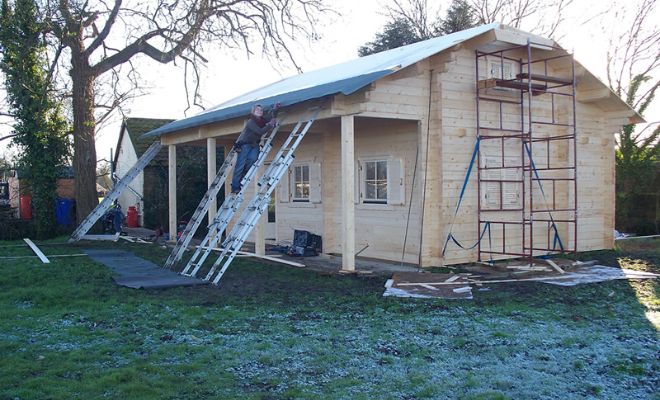
However, if you are doing the work yourself then you will need to arrange the inspections for the appropriate stage of the build and the cost will be determined either by the local authority or an independent building control company.
The Building Regulations that apply to all newly built homes in the UK can be found on the government website.
Planning Permission for Building a Log Cabin
Garden Rooms
For the purposed of planning permission, a garden room log cabin, home office or summer house are classed as outbuildings and as such fall under permitted development rights, providing they meet certain conditions.
Different rules will apply to designated land which includes national parks, the Broads, Areas of Outstanding Natural Beauty, conservation areas and World Heritage sites. The same is true for all listed buildings.
For other properties, a log cabin is not permitted to be built forward of the principal elevation (the side that faces the highway) of the original house. The term ‘original house’ means as it was first built or as it stood on July 1st, 1948 if it was built before that date.
Outbuildings must also not exceed 50% of the land around the original house. To be considered permitted development the log cabin must not be separate, self-contained living accommodation and cannot have a tv aerial.
The log cabin must be single storey and have a maximum height of 4 metres with a maximum of 2.5 metres eaves height when built with a dual pitched roof. If the log cabin has a flat roof it has a maximum permitted height of 3 metres. If the log cabin is within 2 metres of the boundary it must not exceed 2.5 metres in height.
Mobile Home Log Cabin
The planning permission requirements for a log cabin mobile home will depend where it is sited.
If it is within the boundary of your property and it is to be used as an additional living space then you will not need planning permission but it will need to comply with Building Regulations.
For siting the mobile log cabin on an unoccupied piece of land i.e. without an existing dwelling you will need to apply for full planning permission with your local authority. The cost of this will depend on the fees imposed by the local council and you will need to enquire what those costs will be.
You can put a mobile log cabin within woodland that you own in the UK without the need for planning permission as long as it is not used for residential purposes.
If you intend to set up log cabin mobile homes as a commercial venture then you will need to apply to the local council for planning permission and also submit information on the direct and indirect economic value of such a business to the local area.
Residential Log Home
Any log cabin that will be used as a residential dwelling or holiday let will require full planning permission. Architects plans will need to be submitted to the local authority and assessed. The planning process has a standard minimum consultation period of eight weeks so a decision is unlikely before this time period.
This is to allow for objections to the plans to be brought to the attention of the local authority. It may also be necessary to have an Environmental Impact Assessment done and this will add to the timeframe for planning permission.
The cost for planning permission in the UK is around £200 with slight variations between England, Scotland, and Wales.
Demolishing a Log Cabin Cost
A cabin may be demolished because it has become structural unsound, it may be taking up ground that is needed for other purposes or it may be replaced with a different building.
Whatever the reasons the most important thing for the demolition is that it is done safely. For this reason, it is probably best to hire a professional contractor to carry out the work if it is a large residential dwelling.
The cost will depend on the size and condition of the log cabin but you should expect to pay on average between £150-£250 per day or you may be quoted a price for the whole job.
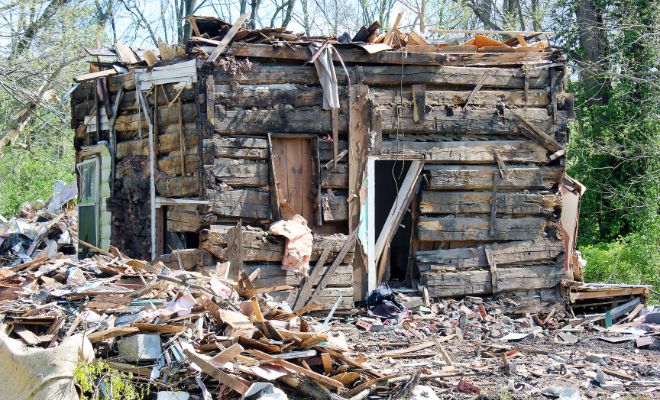
It may be possible to demolish a log cabin yourself if it is a smaller building such as a summer house or other type of garden room. Nevertheless, the job should be approached with caution and the correct equipment used and appropriate safety clothing worn.
You will need to hire a skip to dispose of the waste or arrange for the timber from the log cabin to be recycled in an environmentally sound way. A skip will cost on average between £200-£300 per week depending on where in the country the site is located.
FAQs
They are all dense timbers especially the slow growing varieties in colder climates and some have inherent resistance to fungal or insect attack. Other less dense trees may and absorb water quicker and therefore be more prone to rot.
So, it is not the case that just any tree can be used to build a log cabin and the most suitable and appropriate timber should be used to ensure the longevity of the structure.
You could also use blanket type insulation between the floor joists. It is a good idea to insulate the floor as cold and damp can rise up through the base of your log cabin.
For larger log cabins pillar foundations or strip foundations are better equipped to disperse the weight of the structure down the walls and into the ground.
A pre-treatment of preservative is normally advised for the timber of a log cabin followed by two or three coats of a suitable paint or stain.
A summerhouse or similar garden room type log cabin within the boundary of your property will not need planning permission. Mobile log cabins will need planning permission if they are being built for commercial purposes.
The best place to start is your own bank who may be able to point you in the right direction or get a mortgage broker who can shop around for you.
How to Find & Hire a Log Cabin Builder
If you wish to build a log cabin in order to live in it then you will need to hire a log cabin specialist builder. For a residential log house, the need to have professionals carry out the work is no different to a traditional masonry build as it is a large and complex project.
It is improbable that you will know people who have had log cabins built so getting a personal recommendation may be unlikely. In this event the best course of action is to do some research and find a company who have been in business for a good amount of time and have a strong reputation.
The average cost to build a log cabin as a residence will depend on its size but for a 120 square metre home it will be around £85,000-£120,000 as a design and build project.
Log cabin mobile homes can be supplied and installed for an average cost of between £20,000-£30,000 depending on size and design.
A summer house log cabin or will cost between £500-£1,000 for a two-person team depending on the size of the cabin.
What to Look For
When sourcing a contractor for your log cabin build it may be better to opt for a design and build specialist company. Some will even have their own factories where they machine their own timber and construct the log cabins on site prior to being delivered to the client. This pre-assembly is to ensure that all the timbers fit properly into place.
The separate pieces are numbered and the log cabin then disassembled, transported to the client’s site, and re-assembled using the numbering system Other contractors may specialise in building log cabins but partner with a manufacturer who will produce them.
Qualifications
The qualifications for a log cabin builder will be the specific skills developed through experience and training. Log cabins can be built in different ways, some come as a kit form and have been pre-assembled to ensure all the pieces are present and fit together. Most log cabin builders will be trained and qualified carpenters while those who build hand scribed log cabins will have been specially trained in this skill.
Experience
One of the most important qualities to look for in your log cabin builder is extensive experience. Log cabins are a niche building type and builders of log cabins should be familiar with the specific methods of constructing them. A general builder will probably not be the best choice so look for someone with a lot of experience specifically in building log cabins.
Accreditation
Design and build log cabin builders should be able to prove that the timber that they are using to construct their log cabins comes from a sustainable and managed source.
The accreditations to look for or enquire about are the Programme for the Endorsement of Forest Certification (PEFC) and the Forest Stewardship Council (FSC). For timber grown in the UK it will be the UK Forestry Standard source.
Insurance
The contractor building your log cabin will need adequate insurance and you should ensure that you have proof of this before you sign any contracts. Public liability insurance is essential and protects against injury or damage to third parties during the works.
Professional indemnity insurance provides cover if there is a dispute either about the quality of the work carried out or work not completed. Some contractors may have all risks insurance to protect against property damage and third party claims.
Checking Certifications
Before signing a contract make sure that you have researched the contractor and seen all proofs of insurance and certification. A reputable contractor will offer these without the need to be asked but if not you are within your rights to ask for copies or proof.
Be wary of any company or contractor who are reticent about providing these documents, in such cases you should look for a new contractor.
Sources
https://www.logcabinssouthwest.co.uk/log-cabin-planning-permission/
https://www.woodlandtrust.org.uk/trees-woods-and-wildlife/british-trees/a-z-of-british-trees/
https://www.roofdepot.co.uk/best-flat-roof-systems-in-2020
https://roofcosts.co.uk/
https://www.roundhayroofing.co.uk/how-much-does-it-cost-to-tile-a-roof/
https://britishheritage.com/thatching-old-craft-modern-england
https://www.bsigroup.com/en-GB/about-bsi/media-centre/press-releases/2016/january/Standard-for-residential-park-homes-is-revised-/
https://www.quick-garden.co.uk/log-cabins/homes/
https://www.timberbuildingspecialists.co.uk/collections/garden-log-cabins









